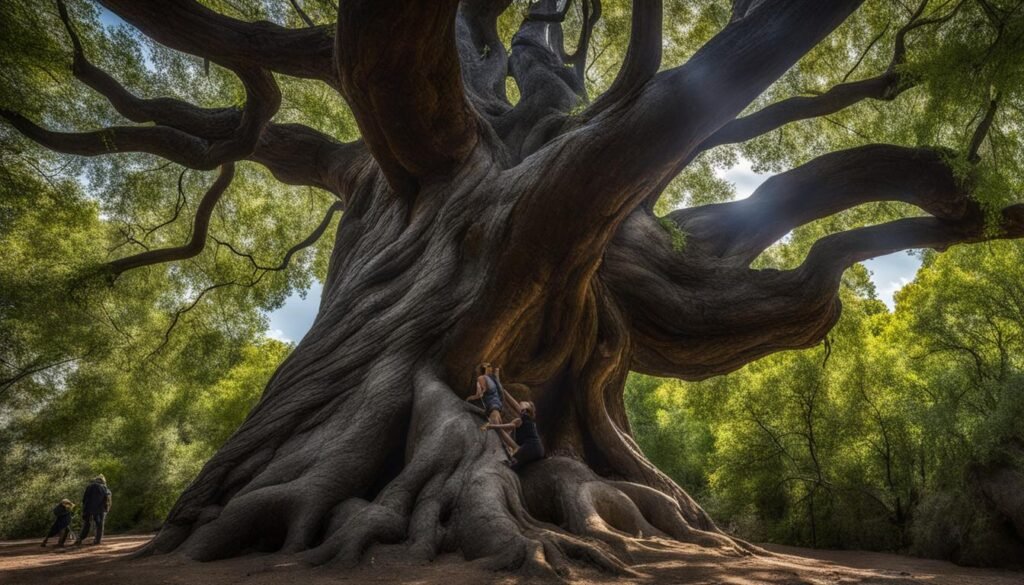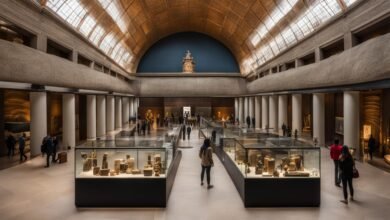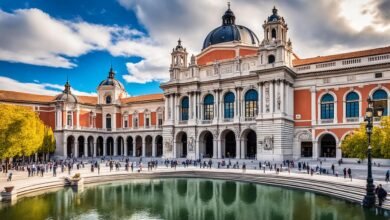Table of Contents
Ever wondered about the mysteries in natural history? Or how a museum helps with science and saving nature? If these questions interest you, get ready for an exciting trip through the Museum of Natural Sciences in Madrid.
In Madrid’s center lies the Museum of Natural Sciences, also known as the National Museum of Natural Sciences. It started in 1771 by King Carlos III as the Royal Cabinet of Natural History. Now, it’s a top scientific research center and home to many rare specimens and artifacts.
The museum offers lots to explore with its big collections, interesting shows, and learning programs. It aims to help us understand the natural world better and how to protect it. You can learn about the museum’s growth, its research work, and educational activities.
Ready to explore the amazing world of the Museum of Natural Sciences in Madrid? Join us on a trip filled with scientific discoveries, incredible exhibits, and a new love for nature.
History and Evolution of the Museum
The National Museum of Natural Sciences in Madrid has an intriguing history. It began as the Royal Cabinet of Natural History in 1771. King Carlos III wanted to share the world’s natural wonders.
Pedro Franco Dávila, a well-known Spanish businessman, made the first donation. He gave thousands of minerals, plants, animals, and art pieces. These items laid the groundwork for the museum’s vast collections.
Over time, the museum expanded its collections thanks to strategic buys and donations from people and groups. This growth made it a top place for studying and saving natural history.
In 1984, the museum was majorly revamped to update its facilities and improve its educational programs. This change made the National Museum of Natural Sciences a vibrant and interesting place, loved by visitors worldwide.
Now, the museum showcases a wide array of specimens and artifacts of historic and scientific importance. Each exhibit, from fossils to geological formations, provides a peek into nature’s marvels and the findings of researchers over the years.
The National Museum of Natural Sciences has become a vault of knowledge. It celebrates our planet’s rich history and sparks curiosity in visitors of all ages.
The museum is noted for its fantastic collections, large library, and dedication to scientific research. It stands as a light of discovery and a vital resource for researchers, scholars, and nature fans.
Exhibitions and Collections
Visit the Museum of Natural Sciences in Madrid and dive into its vast collections. It holds over 6 million specimens. This place is a major hub for learning about Spain’s fauna and the Mediterranean area.
Mediterranean Fauna: Exploring Biodiversity
Enter the Mediterranean Fauna exhibit to see marine and land creatures from this special place. You’ll see colorful fish, interesting reptiles, and amazing mammals. This exhibit shows the area’s rich life and why we must protect it.

History of the Earth: A Journey Through Time
Explore Earth’s past in the History of the Earth exhibit. See amazing fossils that show how life evolved. From water dwellers to dinosaurs like the Diplodocus, travel through time. It shows how life is connected and how our world has changed.
Royal Museum: A Glimpse into the Past
Visit the Royal Museum exhibit for a trip through history. See beautiful artifacts and art from long ago. This exhibit connects nature, exploration, and civilizations. Every piece has a story that tells us about our heritage.
Get lost in the wonders of the natural world at the Museum of Natural Sciences in Madrid. Its displays ignite curiosity and teach us about the planet’s life and history.
Research at the Museum
The National Museum of Natural Sciences is more than just a place to see exhibits. It’s a top research center in Spain. It has experts in areas like paleobiology, geology, ecology, and climate change. Their work helps science move forward.
They work hard to understand our world and its ecosystems better. Their research gives us important info about Earth’s past, present, and future.
Paleobiology looks at old life forms and how they dealt with their surroundings. By looking at fossils, museum researchers find out about our planet’s history. They learn how species evolved and what has shaped Earth.
In geology, the research team studies our planet’s makeup. They look at rocks and minerals to see how Earth has changed over time. This helps us know more about Earth’s past and dangers we might face.
Ecology research at the museum focuses on how living things interact with their home. By studying ecosystems, the team can understand how life balances on Earth. This is key for solving environmental issues and saving important living areas and animals.
The museum also tackles climate change. Scientists look at weather patterns to learn about climate changes. Their work helps us find better ways to deal with these changes.
Overall, the National Museum of Natural Sciences is all about exploring and discovery. Its hardworking researchers help us learn a lot about our world. They guide conservation work and help deal with big world problems.
Research at the Museum – Key Fields and Contributions
| Field of Research | Contributions |
|---|---|
| Paleobiology | Unraveling the secrets of ancient life forms, understanding the evolution of species, and the forces that shaped Earth’s history. |
| Geology | Exploring the Earth’s structure, processes, and materials, providing insights into Earth’s history, natural hazards, and resources. |
| Ecology | Studying ecosystems and their dynamics, contributing to a better understanding of the delicate balance of life on Earth, and informing conservation efforts. |
| Climate Change | Investigating climate patterns, past and present, to comprehend the complex mechanisms driving climate change and developing strategies for mitigation and adaptation. |
Educational Programs and Activities
The Museum of Natural Sciences in Madrid offers fun programs and activities for all ages. If you love nature, are a student, or just curious, you’ll find something to enjoy.
Workshops and Lectures
Join interactive workshops and interesting lectures by science experts. You’ll do hands-on activities, learn about new scientific findings, and get a deeper understanding of nature. Topics include biodiversity, climate change, conservation, and more.
Guided Tours
Take a guided tour to see the museum’s amazing collection. Expert guides will show you around, tell you cool stories, and point out important specimens. If you’re into fossils, minerals, or plants and animals, these tours are very informative and fun.
“At the Museum of Natural Sciences in Madrid, visitors get unique chances to learn and connect with nature. With fun workshops, informative lectures, and interesting tours, the museum helps people understand science better. It makes you curious and amazed by nature. It’s perfect for people and families who want to learn in a fun way.”
Activities for Children
The museum also has special activities for kids. They can try interactive exhibits and workshops made just for them. It’s a great way for kids to learn about nature while having fun. The museum wants to make kids love science and nature.
The Museum of Natural Sciences in Madrid makes learning about science and nature active and fun. There are workshops, talks, tours, and kids’ activities. It helps people know more about our world, keeps them curious, and shows them the beauty of nature. The museum is a great place for learning and family fun.
Architecture and Location
The National Museum of Natural Sciences is in the Palace of the Arts and Industry in Madrid. This grand building from 1882 shows off incredible architecture. It tells of the museum’s rich history and grandeur.
Fernando de la Torriente designed it, with help from Emilio Boix y Merino. The Palace stands as a symbol of artistic and engineering skill from back then. Its detailed and fancy design catches the eye of everyone who visits.
Being in Madrid, Spain’s lively capital, makes the museum easy to get to. It’s a spot that both locals and travelers can easily find. People from all over come to see it.
Discover the Architectural Splendor
Entering the Palace of the Arts and Industry, you’re met with a stunning facade. It has sculptures and decorations that grab your attention. Inside, big galleries and grand halls show off the museum’s displays perfectly.
Look up and see the amazing ceiling details. Notice how light and shadow play around you. The design mixes the old with the new beautifully. It highlights the museum’s varied collections and shows.
If you love architecture or just enjoy beautiful places, the National Museum of Natural Sciences is a must-see. It’s a special chance to dive into both art and science.
Location and Accessibility
The National Museum of Natural Sciences is easy to reach, right in Madrid. You can find it at Calle José Gutiérrez Abascal, 2. It’s near good public transport, making it simple for anyone to visit.
Once there, you’re in the middle of Madrid. Other cultural sites are close by. Use the museum’s central spot to see more of the city and enjoy your time there.
Interested in nature, architecture, or just want a fantastic museum experience? The National Museum of Natural Sciences is the place. Plan your visit and start an amazing journey into natural wonders.
Importance and Impact
The Museum of Natural Sciences in Madrid is key in spreading science knowledge and conservation awareness. Its collections, exhibits, and programs show the beauty of nature. They also highlight how to protect it.
“The preservation of our planet’s biodiversity is of utmost importance for the well-being of current and future generations.”
The museum helps us understand how living things interact with their surroundings. It encourages visitors to learn more about science and value nature deeply.
Its exhibits stress the need to keep ecosystems and biodiversity safe. The museum offers interactive and educational experiences. These inspire people to act for a green future.
The museum’s influence goes beyond its walls. Its research, partnerships, and educational activities spread environmental care. This builds a culture focused on loving the planet and seeking knowledge.

Conservation Through Education
The Museum of Natural Sciences is big on teaching about the environment to everyone. It offers workshops and lectures that make people more eco-aware.
- Interactive workshops let people learn about nature by doing things themselves.
- Lectures from experts talk about new research and environmental issues.
- Guided tours take visitors through the museum, showing why we need to protect nature.
- Activities designed for families and kids spark interest and love for the environment.
The museum stands as a pillar of science, encouraging us to care for our world. It ignites wonder and teaches about life’s connections. This encourages us to safeguard our ecosystems.
Conservation Efforts and Research
The museum does more than educate; it also leads in conservation research. Its work in fields like paleobiology and climate change helps us grasp nature better.
Its studies help the world’s conservation efforts. The museum looks at how humans affect biodiversity and ecosystems. It also focuses on saving endangered species.
The museum’s researchers use new tech and work with others. They are important in finding new ways to conserve nature and teach others.
| Conservation Achievements | Research Areas |
|---|---|
| Establishment of protected areas to preserve endangered species | Paleobiology |
| Development of conservation plans for critical ecosystems | Geology |
| Monitoring and study of climate change impacts on biodiversity | Ecology |
| Collaboration with international organizations to combat wildlife trafficking | Climate Change |
The Museum of Natural Sciences in Madrid makes a real difference. It educates, researches, and works globally to keep our natural world thriving. Its efforts in science and conservation are vital for our planet.
Visitor Information and Contact Details
Want to visit the National Museum of Natural Sciences in Madrid? Here’s what you need to know to enjoy your time.
Address:
We’re at Calle José Gutiérrez Abascal, 2, Madrid, Spain. Use GPS or ask around to find us easily.
Contact Information:
Got questions? We’re here to help. Email us at infor.edu@mncn.csic.es or call +34 914111328.
Website:
Check out www.mncn.csic.es for the latest on exhibits and visitor info. It’s your go-to for planning your visit.
Remember to book your tickets early. This way, you can avoid lines and make the most of your museum visit!
Plan Your Visit to the Museum
Get ready for a journey when you visit the Museum of Natural Sciences in Madrid. This museum is among the top in Madrid, inviting you into the natural world’s mysteries. Its wide array of collections lets you dive into nature’s marvels.
Before you go, check the museum’s official website or get in touch directly for up-to-date info. This includes opening hours and ticket prices. This ensures your visit goes smoothly. Opening hours may change, so verifying in advance is smart.
At the museum, you can expect a range of exhibits and programs that enlighten and amaze. You’ll see earth’s history and life unfold and learn about the Mediterranean’s wildlife. It’s a place where nature fans, young and old, can learn and be wowed. So, head to the Museum of Natural Sciences in Madrid for an adventure in learning.




